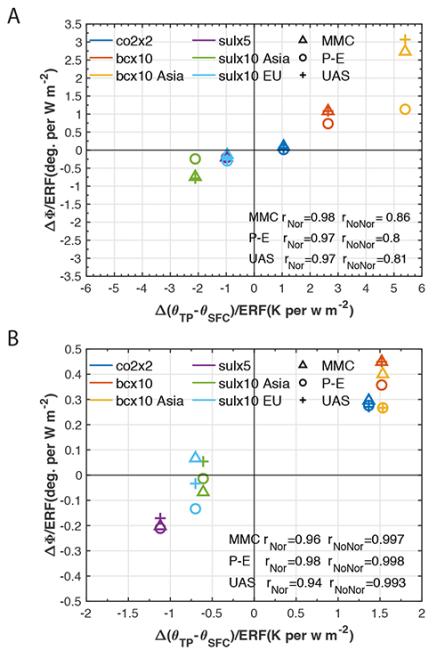Tropical belt width proportionately more sensitive to aerosols than greenhouse gases
Internal variability and anthropogenic forcing have contributed to widening of the tropical belt during the last several decades. Although greenhouse gas (GHG) emissions and stratospheric ozone depletion have been implicated as primary anthropogenic drivers of tropical expansion, the overall role of anthropogenic drivers is complex and the relative importance of individual anthropogenic drivers—including aerosols—remains uncertain. To better understand the effect of these individual drivers on tropical belt width variations, Zhao, Allen, and coauthors utilize idealized simulations with very large single forcing perturbations in comprehensive coupled ocean-atmosphere models from the Precipitation Driver and Response Model Intercomparison Project (PDRMIP).

Figure 1. Efficacy of tropical width perturbations versus normalized extratropical static stability. Scatterplot of the annual mean ensemble mean (A) Northern and (B) Southern Hemisphere tropical belt edge response versus the corresponding subtropical static stability response. The subtropical static stability is the potential temperature difference between the tropopause and surface (θTP − θSFC), averaged over 30-60° latitude, and the response (perturbation minus baseline) is normalized by the absolute value of the corresponding global effective radiative forcing (ERF). The tropical belt edge response is based on the Mean Meridional Circulation (MMC), precipitation minus evaporation (P-E), and surface zonal wind (UAS) metrics, as represented by the different symbols. A positive (negative) tropical belt edge response indicates tropical expansion (contraction). Also included are the correlations between the normalized (rNor) and unnormalized (rNoNor) tropical belt edge and extratropical static stability responses. Note the different x-axis and y-axis between the two panels. Click image to enlarge.
Figure 1 shows that black carbon (BC) aerosol, which heats the atmosphere via absorption of shortwave radiation, drives tropical expansion. In contrast, scattering sulfate aerosol drives contraction. Normalizing the tropical belt response by the corresponding global effective radiative forcing (ERF) shows that BC in the Northern Hemisphere (NH) is more efficient than GHGs in driving tropical expansion, particularly BC emitted from Asia. In the Southern Hemisphere (SH), anthropogenic aerosols generally show smaller efficacy in driving tropical edge perturbations as compared to the NH—but the aerosol efficacy in the SH is still comparable to the SH GHG efficacy. For both hemispheres, the authors demonstrated similar results when tropical belt width responses are normalized by the change in global mean surface temperature, as opposed to ERF (not shown). These results highlight the importance of aerosols, particularly BC, and the forcing location, with Asian BC particularly efficient, at perturbing the width of the tropical belt.
Dynamical mechanisms controlling tropical belt widening remain uncertain. A scaling relation exists between the location of Hadley cell edge and the poleward extent to which angular momentum conservation continues until the resulting vertical shear becomes baroclinically unstable. Consistent with this scaling relation, tropical belt expansion (contraction) is associated with an increase (decrease) in extratropical static stability induced by absorbing (scattering) aerosol (Figure 1).
Although a formal attribution accounting for the spatial and temporal anthropogenic aerosol variations is difficult using the PDRMIP idealized simulations with unrealistically large forcing load, the impact of anthropogenic drivers on tropical widening due to observed emission changes is approximated by calibrating the normalized expansion rates to the historical (1750-2011) time period. This suggests that BC has likely caused a substantial portion of NH tropical widening over the historical time period, but with relatively large uncertainty. In addition, these results imply a possibly large role of aerosols in future perturbations to the width of the tropical belt. Large reductions in aerosol emissions over the next few decades are anticipated, including emissions from Asia.
Tropical Belt Width Proportionately More Sensitive to Aerosols Than Greenhouse Gases (Geophysical Research Letters)
Topics
- Modeling
